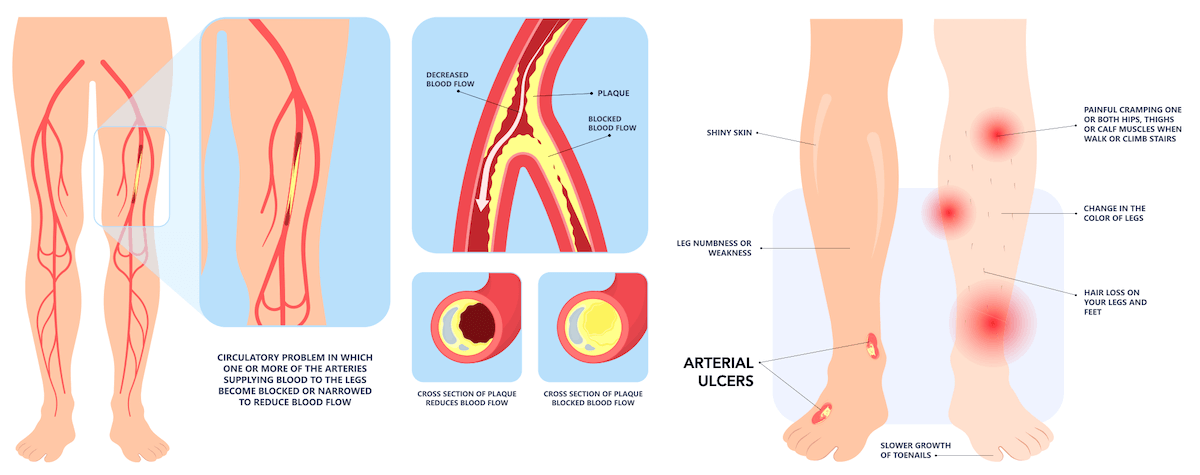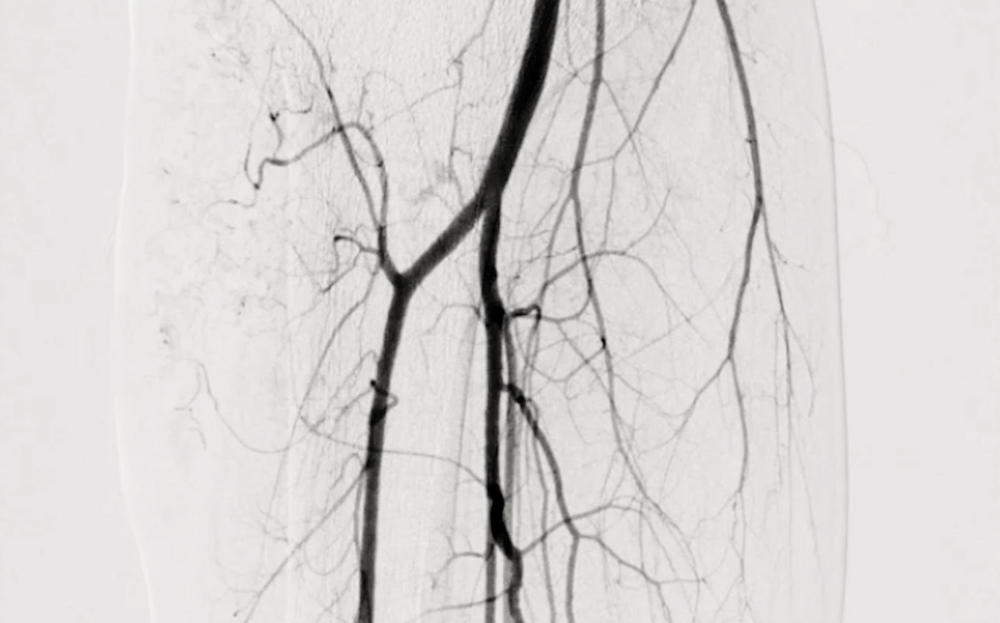Lower Extremity Arterial Disease Doctor in Los Angeles

Do you have lower extremity arterial disease? Learn what it is, how to spot symptoms, and your treatment options in this quick overview from lower extremity arterial disease doctor Michael Lalezarian. He performs lower extremity arterial disease treatment in the Los Angeles area.
Quick Navigation:
Lower Extremity Arterial Disease Doctor
Risk Factors of Lower Extremity Arterial Disease
Symptoms of Lower Extremity Arterial Disease
Diagnosing Lower Extremity Arterial Disease
Lower Extremity Arterial Disease Treatment
Lower Extremity Arterial Disease Surgery

Lower Extremity Arterial Disease Doctor
Dr. Michael Lalezarian
What is Lower Extremity Arterial Disease?
Risk Factors of Lower Extremity Arterial Disease

Lower Extremity Arterial Disease Symptoms
Do you experience cramping pain in your legs or buttocks after walking long distances? This is one of the most telling signs of lower extremity arterial disease, and it tends to get worse if left untreated. Review these lower extremity arterial disease symptoms to learn if you might have it.
Leg Discomfort: Generalized leg discomfort should be cause for alarm in diabetics, smokers, and the elderly. Leg pain is certainly not specific to lower extremity arterial disease, but it may be the first sign that vascular issues are present.
Claudication: Claudication describes a cramping pain that is felt in the hips, thighs, buttocks, calves, or feet during exercise that then subsides when resting. This is the most telling symptom of lower extremity arterial disease and should be taken very seriously.
Cold Feet: Lack of blood flow and poor vascularity can render the lower extremity exceptionally cold. Cold feet can indicate lower extremity arterial disease, especially when one foot is significantly colder than the other.
Weak Pulse: A simple pulse check can be very telling. A weak or absent pulse at the groin, behind the knee, on the inner ankle, or on the top of the foot can indicate lower extremity arterial disease.
Rest Pain: Pain may persist even when sitting or lying down. This pain typically affects the forefoot and toes. By the time patients experience rest pain, it is likely that lower extremity arterial disease has progressed to an advanced stage.
Tissue Loss: Tissue loss occurs when tissue in the leg or the foot does not have an adequate blood supply. This can present as skin color changes, open wounds, and sores. Tissue loss is a late-stage symptom of lower extremity arterial disease.
Lower Extremity Arterial Disease Doctor

Diagnosing Lower Extremity Arterial Disease

Lower Extremity Arterial Disease Treatment
Lower extremity arterial disease treatments include lifestyle changes, medications, minimally invasive procedures, and invasive surgical options. Review your options below.
Lifestyle & Medications
Patients whose symptoms are mild to moderate can often manage their disease by making lifestyle changes such as quitting smoking, improving diet, and getting regular exercise. It’s also important to work with your doctor(s) to manage related conditions, such as diabetes, hypertension, and high cholesterol. Your doctor may also prescribe blood-thinning drugs or other firstline medications to help control the progression of lower extremity arterial disease.
Minimally Invasive Treatment
When lower extremity arterial disease is severe enough to warrant interventional treatment, the goal is to open blocked vessels and re-establish blood flow throughout the legs and feet. At ProVascularMD, we have extensive experience in lower extremity arterial treatments including balloon angioplasty, stenting, and atherectomy. We also partner with our colleagues in wound care, podiatry, endocrinology, vascular surgery, and other specialties that are essential to healing the lower extremities. Learn more about the lower extremity arterial disease treatments that we offer below.
Balloon Angioplasty: Balloon angioplasty involves threading a wire through the narrowed or blocked artery along the length of the blood vessel. A deflated balloon is placed over the wire and then inflated, opening the blockage and allowing blood to flow more freely through the treated artery.
Stenting: Stenting involves the placement of a small tubular device that holds the artery open, often immediately after balloon angioplasty is performed. The goal of stenting is to prevent the artery from closing again and to help maintain healthy blood flow.
Atherectomy: Atherectomy devices cut through or shave away tough plaque in the artery, not unlike a drill or a sanding device. Atherectomy is typically reserved for totally occluded arteries or arteries with hard, calcified plaques that are unsafe to open with balloon angioplasty alone.
Surgery for Lower Extremity Arterial Disease
When minimally invasive treatment is not an option, you may be referred to a vascular surgeon for surgery for lower extremity arterial disease. Bypass surgery and endarterectomy are two of the more common, last-option treatments for lower extremity arterial disease.
Bypass Surgery: Bypass surgery can be used to re-establish blood flow between a proximal artery (closer to the heart) and one that’s more distal (farther from the heart) by grafting in a vessel. Bypass surgery is often used when minimally invasive treatment is not possible.
Endarterectomy: Endarterectomy is the surgical removal of part of the inner lining of the artery along with any plaque deposits that may be obstructing the vessel. Endarterectomy is a common approach to lower extremity arterial disease when minimally invasive treatment is not possible.
Lower Extremity Arterial Disease
Peripheral Arterial Disease Treatment
What Are Arterial Ulcers?
Vascular Specialist in Los Angeles
Learn more about Los Angeles Vascular Specialist Dr. Michael Lalezarian.
Schedule Your Visit
Click the Chat Button
Vascular Care in Los Angeles
& San Bernardino County
Adelanto
Alhambra
Amboy
Angelus Oaks
Apple Valley
Arcadia
Azusa
Baker
Baldwin Park
Barstow
Bell Gardens
Big Bear City
Big Bear Lake
Bloomington
Blue Jay
Bryn Mawr
Burbank
Cedar Glen
Cedarpines Park
Chino
Chino Hills
Cima
Citrus
City of Industry
Claremont
Colton
Covina
Crestline
Daggett
Diamond Bar
Downey
Duarte
Eagle Rock
Earp
El Monte
Essex
Fawnskin
Fontana
Forest Falls
Fort Irwin
Glendale
Glendora
Grand Terrace
Green Valley Lake
Guasti
Hacienda Heights
Helendale
Hesperia
Highland
Highland Park
Hinkley
Irwindale
Joshua Tree
La Canada
La Crescenta
La Habra
La Mirada
La Puente
La Verne
Lake Arrowhead
Landers
Loma Linda
Lucerne Valley
Ludlow
Lytle Creek
Mentone
Monrovia
Montclair
Montebello
Monterey Park
Morongo Valley
Mountain Pass
Mt Baldy
Needles
Newberry Springs
Nipton
Norwalk
Ontario
Oro Grande
Parker Dam
Pasadena
Phelan
Pico Rivera
Pinon Hills
Pioneertown
Pomona
Rancho Cucamonga
Redlands
Rialto
Rimforest
Rosemead
Running Springs
San Bernardino
San Dimas
San Gabriel
Santa Fe Springs
Sierra Madre
Skyforest
South El Monte
South Pasadena
Sugarloaf
Temple City
Trona
Twentynine Palms
Twin Peaks
Upland
Victorville
Vidal
Walnut
West Covina
West San Dimas
Whittier
Wrightwood
Yermo
Yucaipa
Yucca Valley





